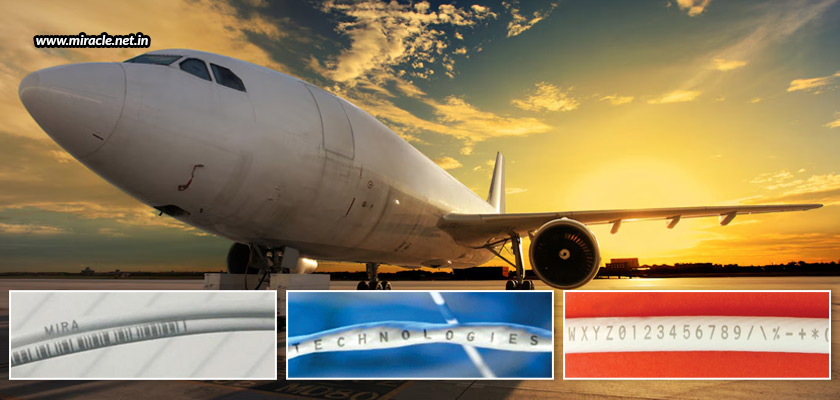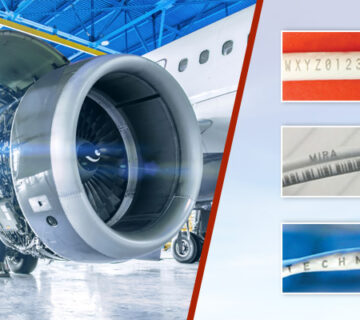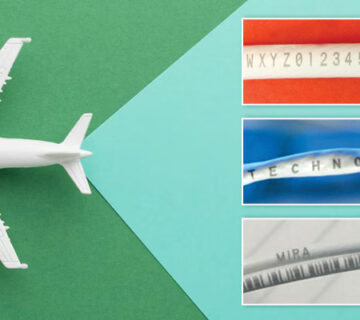Accurate identification of aircraft cables is essential for maintenance and safety in the aviation industry. Ensuring proper cable labelling and tracking promotes effective maintenance practices and expedites troubleshooting in the event of problems. For this reason, laser marking technology has shown to be a dependable option, as it provides durability and adaptability when marking a variety of materials that are frequently used in aviation cables. Meeting regulatory criteria and raising general safety standards in the aviation industry are made possible in large part by this technology. In addition, routine maintenance inspections of laser-marked cables guarantee continued compliance and reliability, which supports the seamless functioning of aviation systems. Come let’s examine the compatibility of materials for laser marking for aircraft cables, various identification techniques, and the maintenance and durability of such cables.
Materials fit for aircraft cable laser marking
To maintain the safety and dependability of flight, the cables used within the aircraft, which are responsible for power transfer, communications, and system control, must be capable of enduring a variety of climatic elements, mechanical forces, and operating conditions. Therefore, it is important to choose appropriate materials for manufacturing these cables, in order to satisfy the strict requirements of the aviation industry. Aircraft cables are frequently made of aluminium, stainless steel, and specialized alloys, with each material having certain qualities that add to the overall effectiveness and durability of the cables.
- Aluminium: Due to its lightweight nature, aluminium is frequently utilized in aircraft cables, improving overall performance and fuel economy. Aluminium cables have enough strength and flexibility to fulfil the rigorous requirements of aeronautical applications, even though they weigh less than stainless steel cables. Aluminium cables are also a good fit for laser marking as they offer durable identification markings without sacrificing the integrity of the material.
- Stainless steel: Stainless steel’s remarkable strength, resistance to corrosion, and longevity make it a preferred material for aircraft cables. It is resistant to a variety of challenging environmental factors, such as high temperatures, high humidity, and chemical exposure. Furthermore, stainless steel cables are very flexible and have a high tensile strength, which makes them perfect for situations where dependability and accuracy are crucial. Because of these characteristics, stainless steel is ideal for laser marking procedures, providing identification marks that are durable and legible enough to survive the demands of airline operations.
- Specialized alloys: Another class of materials used in aviation cables are specialised alloys, which have certain qualities designed to meet the particular needs of aeronautical applications. Depending on the intended use, these alloys are frequently made to improve mechanical strength, conductivity, or corrosion resistance. A large variety of specialized alloys may be used with laser marking technology, enabling accurate and long-lasting identifying marks that meet industrial and legal requirements.
For aviation systems to operate safely, reliably, and effectively, the right materials must be chosen for the cables. Specialized alloys, aluminium, and stainless steel all have distinct qualities that make them suitable for aircraft purposes. By offering accurate and long-lasting identifying marks, laser marking technology enhances these materials, contributing to the efficient operation and maintenance of aircraft cables in the aviation industry.
Laser marking techniques for identification
With a variety of versatile techniques for identifying aircraft cables, laser marking stands as a powerful technology in the aviation industry. The application of laser marking techniques becomes essential in the complex web of aircraft operations, where safety, traceability, and regulatory compliance are of utmost importance.
- Alphanumeric coding: The usage of alphanumeric codes is the backbone of laser marking. These codes provide every aircraft cable a unique identification inside the massive aviation infrastructure. Alphanumeric codes are created by carefully engraving characters onto the surface of cables; the codes forming the basis for maintenance records and traceability. These codes are used by aviation experts to monitor the service life of cables, right from the point of manufacture up till their installation and maintenance. Each cable’s story is revealed through alphanumeric codes, which also provide information about the cable’s history, purpose, and journey through the skies.
- Barcoding: Barcodes are a simplified method of cable identification, offering a quick and efficient scanning method that makes it possible to retrieve and process data quickly. Barcodes make inventory management and maintenance procedures easier in the fast-paced, time-sensitive aviation industry. Aviation specialists may obtain essential details about the cable, such as its specifications, maintenance requirements, and installation date, by simply scanning the barcode. This expedited approach of data retrieval reduces the possibility of mistakes that are often linked to manual data entry, while also improving operational efficiency.
- 2D matrix coding: 2D matrix codes take cable identification to new levels of intricacy, with high-density data encoding that enables the storing of comprehensive information within one tiny symbol. Because of their sophisticated encoding capabilities, 2D matrix codes are perfect for preserving minute information like product specifications, serial numbers, and manufacturing dates. 2D matrix codes optimize space utilization and allow for thorough tracking of cable information over the course of its lifespan by combining a multitude of data into a single code.
Each method—from barcodes and 2D matrix codes to alphanumeric codes—offers a special set of benefits designed to satisfy the various demands of aviation experts. In any way, aircraft cable identification laser marking procedures are the ultimate in technological innovation, which result in enhanced safety, efficiency, and compliance in aviation operations by integrating these methods seamlessly into aircraft cable identification procedures. This guarantees that the skies will always be a world of unmatched accuracy and dependability.
Maintenance and durability of laser-marked aircraft cables
The longevity and durability of laser-marked identification on aircraft cables are critical elements in guaranteeing the dependability and security of aviation systems. With its ability to provide robust and long-lasting identification markings that can resist the rigours of aircraft settings, laser marking technology has emerged as a cornerstone solution.
- Durability: Because laser markings are inherently robust, they can endure the challenging environmental conditions that are common in airline operations. These markings demonstrate resilience against extreme temperatures, high humidity, and exposure to chemicals, guaranteeing that their integrity will not be compromised even in challenging conditions. Laser markings maintain their clarity and legibility, and thus reliable identification throughout the lifespan of aircraft cables, unlike traditional marking techniques that may fade or deteriorate over time.
- Enhanced durability: Using sealants or protective coatings can help improve the longevity of laser markings, proving to be a durability enhancer The lifespan of the identification marks on aircraft wires can be elongated and guaranteed with the help of these coatings, which can offer an extra layer of defence against environmental elements.
- Maintenance: Maintaining the longevity of laser-marked identification requires regular maintenance. To guarantee that laser marks remain effective, aviation maintenance personnel must conduct frequent inspections and maintenance procedures. The legibility and integrity of laser markings should be examined as part of these routines to ensure that they adhere to legal requirements and contribute to the overall safety of aircraft operations.
- Inspection: Regular inspections are important to make sure that the laser markings remain clear and readable. Corrective action must be taken in response to any deterioration or damage in order to preserve regulatory compliance. Furthermore, maintenance personnel may make use of specialized tools, such as laser scanners, to confirm the precision and legibility of laser marks, especially in locations where physical inspection can be difficult.
The non-intrusive nature of laser marking technology is a significant benefit as it reduces the possibility of damaging the wires during the identification procedure. Conventional techniques, including etching or stamping, might weaken the cables’ structural integrity and create possible weak points. On the contrary, laser marking offers a precise and regulated means of identification, while maintaining the structural and functional aspects of the cables. And, with the above-mentioned tips and strategies, the durability of such identification marks can be further enhanced.
Aviation safety is enhanced by the swift and precise identification of aircraft cables made possible with laser marking technology. As the aviation industry develops, adopting this technology, which Miracle Electronics is a prime example of, is essential to preserving the highest standards of safety and reliability in aircraft cable identification. With Miracle Electronics’ laser marking for aircraft cables, aviation professionals can satisfy industry requirements, while maintaining the highest standards of safety and reliability in aircraft cable identification.




